|
|
|||
|
(Back to Preceding Week; on to Next Week) |
|
2007 BIRD BANDING TOTALS:
STRIKING GOLD Click on chart above to open a larger image in a new browser window All text, charts, tables & photos © Hilton Pond Center Every year of our on-going bird banding program at Hilton Pond Center is unique. Each check of our mist nets and traps is filled with anticipation and excitement because we never know what may show up next. Likewise, we don't know until year's end how many birds of how many species we will have been privileged to handle during the 12-month period. After a dismal year in 2006 with only 1,501 birds banded from 37 species, we rebounded in 2007 with 2,084 individuals and 66 species--both above our 26-year average at the Center (see chart above). That said, we wouldn't have had a very good year at all had we not struck gold beginning in early November.
When we say we "struck gold" we really mean to say the cool days of November brought the first of several waves of American Goldfinches (non-breeding male above)--a species that has always been regular in winter around Hilton Pond but that appeared this year in unprecedented numbers. In all we banded 838 AMGO in 2007--obliterating the previous annual total of 529 set back in 1990. Only the 950 Purple Finches we captured in 2004 had a higher single-species annual total than this year's AMGO. This American Goldfinch invasion cemented the species in position as the third-most-common bird captured at the Center with 6,800 banded since 1982 (see chart above)--exceeded only by House Finches (7,634) and Purple Finches (7,176). If things don't pick up for PUFI as this winter continues, AMGO very well may move into the #2 spot. (Note on the above chart that AMGO, PUFI, HOFI, and Pine Siskins--our four "winter finches"--make up 46.15% of all bird banded at Hilton Pond.)
Although AMGO did smother our old record for bandings in a calendar year (see chart above), it's interesting the tally so far for the WINTER of 2007-08 has not been so different from those in previous winters (see chart below). Like everyone else we consider the "calendar year" to be 1 January through 31 December as depicted in the chart above, but for the sake of simplicity we designate "winter" as 1 July of one year through 30 June of the next year. This works pretty well for understanding movements and populations of birds such as winter finches, Yellow-rumped Warblers, and White-throated Sparrows that breed up north and come south to spend the cold months.
Because we've caught female AMGO in summer with pronounced brood patches, we know the species breeds at or near Hilton Pond Center; however, the vast majority of AMGO we band are almost certainly migrants from elsewhere. And, because new AMGO always appear as cold weather continues, it's possible the 489 goldfinches banded so far this winter will eventually surpass the record of 748 banded during the winter of 1989-90--although our two hummingbird banding expeditions to Costa Rica in January and February 2008 will conflict with our Hilton Pond winter banding schedule. (We're not complaining.) Because Ruby-throated Hummingbirds (adult male, below right) are our main summer focus, we should reiterate our banding results for 2007 (see chart above). Our best year ever was two years ago (2005) when we banded 226 RTHU. For some reason there was a big drop last year with only 164 hummers captured, During our presentations around the country folks often ask us about the "rarest" or "most unusual" bird we've banded at Hilton Pond Center, so this year we decided to create a few arbitrary categories along those lines.
Our "Hardest-to-Get Bird" for 2007 was the Northern Saw-whet Owl (above), lured in with an audio tape on the night of 15 December. This was our tenth NSWO captured at Hilton Pond Center and only the 15th banded in South Carolina; the other five were all netted in the Sandhills or Coastal Plain.
The "Most Noteworthy Bird" in 2007 was the raspberry-red male House Finch (above) we caught on 7 December. This individual was our 50,000th bird banded at Hilton Pond Center since our work began in June 1982.
The "Best Reappearance Award" for 2007 was a tie between Yellow-rumped Warbler and Northern Cardinal, both of which were captured at rates considerably higher than in recent years. Yellow-rumps (see chart above) are one of our most unpredictable winter migrants. Some years we were away from Hilton Pond for large portions or all the winter banding period, so it's difficult to find YRWA trends based on banding results. What IS apparent is we banded precious few YRWA during the preceding nine years--a lowly average of 30 birds since 1998. Thus, this year's 142 "butterbutts" banded was a welcome increase worthy of a "Best Reappearance" designation.
Northern Cardinals share the "Best Reappearance" award because of a similar increase in 2007. During the seven-year span from 2000 to 2006, we averaged only about 64 NOCA, but in 2007 our nets and traps snared 120 individuals--the first time we've had more than a hundred NOCA at Hilton Pond Center since 1994. We're not sure of all the factors that may have caused this increase, but because almost all our autumn birds were recent fledglings we conclude NOCA had a pretty successful breeding season in 2007.
The comprehensive table below--which lists our complete banding totals for 2007--documents several species for which we had record numbers banded this year at Hilton Pond Center. In addition to the previously mentioned American Goldfinches, these include Carolina Chickadee (24 banded in 2007, equalling a previous high set in 1990); Rose-breasted Grosbeak (five, surpassing the old record of four set in 1992; adult male above); our second-ever Cooper's Hawk (our first was banded in 2004); Red-breasted Nuthatch (three, surpassing the old record of two from 1985 and 1996); Fox Sparrow (eight; surpassing the old record of five set in 1990); and, Scarlet Tanager (13, surpassing the old record of 11 set in 1995; adult male below). We also saw average or above-average numbers for a surprising 25 species banded in 2007, noted in GREEN or RED on the table at the end of this report.
In summary, compared with our preceding 25 years of research at Hilton Pond Center, 2007 was above-average with 66 species and 2,064 individuals banded. American Goldfinches provided a big boost to our numbers, but with record-tying or -breaking tallies for 25 species, we still look upon 2007 as a pretty good year and certainly one of the most diverse in the past decade or so. As the clock strikes midnight on 31 December, we reset our banding spreadsheet and embark upon our 27th year of work at Hilton Pond, always anticipating and excited about what a new 12 months of trapping and mist-netting will bring.
All text, charts, tables & photos © Hilton Pond Center
All text, charts, tables & photos © Hilton Pond Center
Comments or questions about this week's installment?
Thanks to the following fine folks for recent gifts in support of Hilton Pond Center for Piedmont Natural History and/or Operation RubyThroat: The Hummingbird Project. Your tax-deductible contributions allow us to continue writing, photographing, and sharing "This Week at Hilton Pond." (Please see Support if you'd like to make a gift of your own.)
IMPORTANT NOTE: If you ever shop on-line, you may be interested in becoming a member of iGive, through which nearly 700 on-line stores from Barnes & Noble to Lands' End will donate a percentage of your purchase price in support of Hilton Pond Center and Operation RubyThroat. For every new member who signs up and makes an on-line purchase iGive will donate an ADDITIONAL $5 to the Center. Please sign up by going to the iGive Web site; as of this week, 117 members have signed up to help Hilton Pond Center. It's a painless, important way for YOU to support our work in conservation, education, and research. "This Week at Hilton Pond" is written & photographed You may wish to consult our Index of all nature topics covered since February 2000. You can also use our on-line Hilton Pond Search Engine at the bottom of this page. For a free, non-fattening, on-line subscription to |
|
Make direct donations on-line through
Network for Good: |
|
|
LIKE TO SHOP ON-LINE?
Donate a portion of your purchase price from 700+ top on-line stores via iGive: |
|
|
Use your PayPal account
to make direct donations: |
|
| The highly coveted Operation RubyThroat T-shirt --four-color silk-screened--is made of top-quality 100% white cotton--highlights the Operation RubyThroat logo on the front and the project's Web address (www.rubythroat.org) across the back.
Now you can wear this unique shirt AND help support Operation RubyThroat: The Hummingbird Project and Hilton Pond Center. Be sure to let us know your mailing address and adult shirt size: Small (suitable for children), Medium, Large, X-Large, or XX-Large. These shirts don't shrink! Price ($21.50) includes U.S. shipping. A major gift of $1,000 gets you two Special Edition T-shirts with "Major Donor" on the sleeve. |
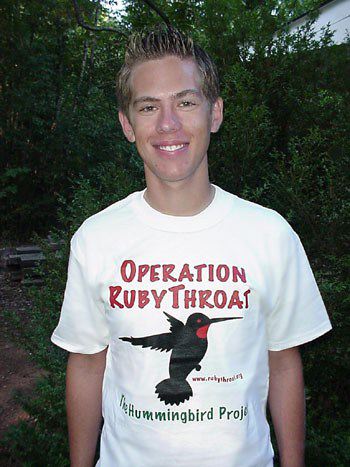
Need a Special Gift just in time for the Holidays? (Or maybe you'd like to make a tax-deductible donation during 2007) If so, why not use our new handy-dandy on-line Google Checkout below to place your secure credit card order or become a Major Donor today? |
|
|
|
|
SPECIES BANDED THIS WEEK: * = New species for 2007 WEEKLY BANDING TOTAL 5 species 53 individuals YEARLY BANDING TOTAL (2007) 66 species 2,084 individuals 26-YEAR BANDING GRAND TOTAL (since 28 June 1982) 124 species 50,167 individuals NOTABLE RECAPTURES THIS WEEK (with original banding date, sex, and current age) American Goldfinch (2) 03/02/05--4th year female 02/05/06--3rd year female Dark-eyed Junco (1) Northern Cardinal (1)
|
OTHER NATURE NOTES OF INTEREST --Despite the scarcity of precipitation across the Carolina Piedmont, another 1.25" of rain at Hilton Pond Center and elsewhere on New Year's Eve meant 2007 was no longer the driest year on record--but only by a quarter-inch or so. We fervently hope everyone's resolutions list for 2008 includes several steps they're going to take to conserve water--and all our other valuable but finite natural resources. --Hilton Pond banding summaries for seven years preceding are on-line at 2006, 2005, 2004, 2003, 2002, 2001, and 2000. All text & photos © Hilton Pond Center
|
|
|
|
(Back to Preceding Week; on to Next Week) Up to Top of Page Back to This Week at Hilton Pond Center Current Weather Conditions at Hilton Pond Center |
 You can also post questions for The Piedmont Naturalist |
Join the |
Search Engine for |
|
|
Cheap Ink Cartridge

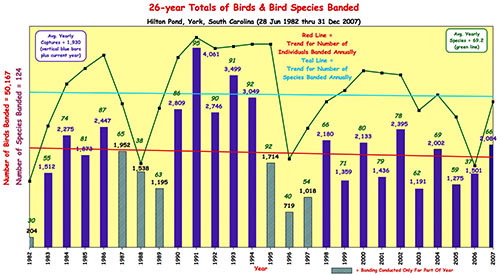
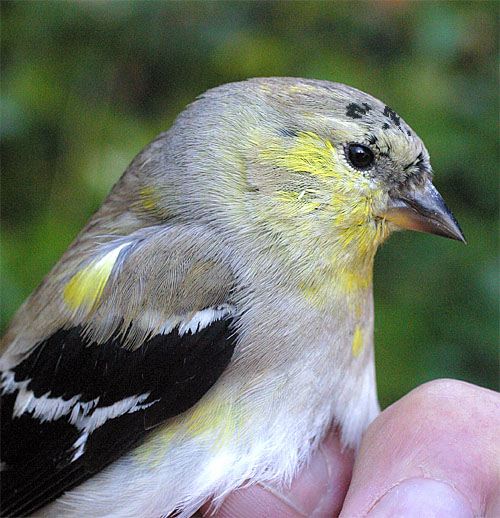
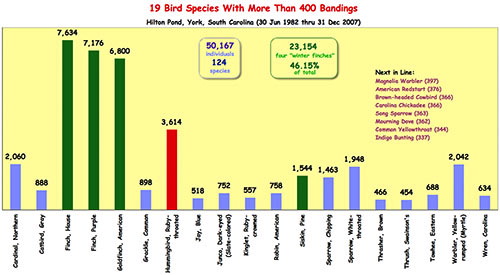

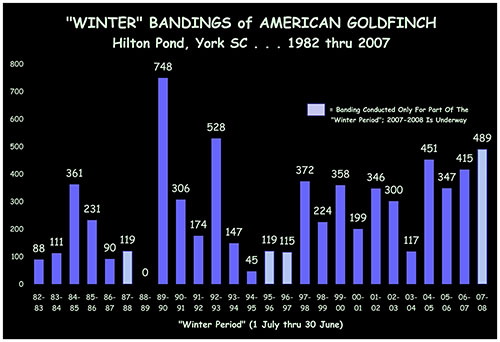
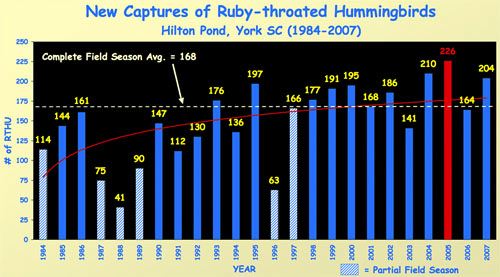
 but the Hilton Pond population--which includes both breeding birds and spring and fall migrants--rebounded nicely in 2007 to our third-best total of 204 birds. This was also well above our 18-year average of 168, a figure that does not include the six partial field seasons for which we were away from Hilton Pond for significant portions of the summer. If we can trust the red trend line on the chart above, RTHU do indeed appear to be on the increase at the Center; we doubt the upward curve is a result of our becoming more experienced at catching hummers, nor does it reflect more hours of trapping and mist netting. Perhaps our numbers reflect what we and some other hummingbird experts believe: Ruby-throated Hummingbirds are adapting well and thriving in suburban backyards in the U.S. and Canada where there are plenty of feeders, hummingbird flowers, and "edge habitats."
but the Hilton Pond population--which includes both breeding birds and spring and fall migrants--rebounded nicely in 2007 to our third-best total of 204 birds. This was also well above our 18-year average of 168, a figure that does not include the six partial field seasons for which we were away from Hilton Pond for significant portions of the summer. If we can trust the red trend line on the chart above, RTHU do indeed appear to be on the increase at the Center; we doubt the upward curve is a result of our becoming more experienced at catching hummers, nor does it reflect more hours of trapping and mist netting. Perhaps our numbers reflect what we and some other hummingbird experts believe: Ruby-throated Hummingbirds are adapting well and thriving in suburban backyards in the U.S. and Canada where there are plenty of feeders, hummingbird flowers, and "edge habitats."


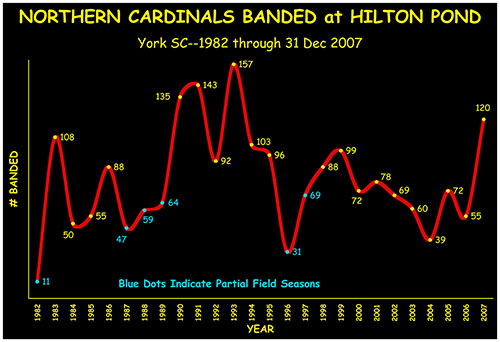
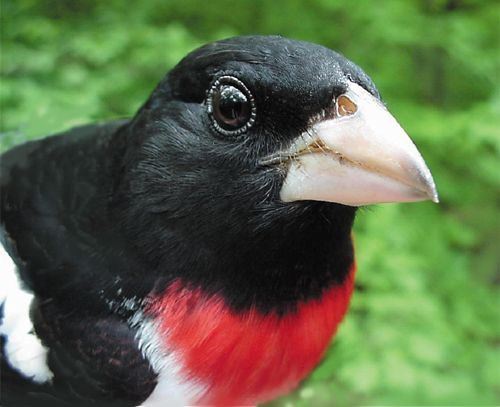
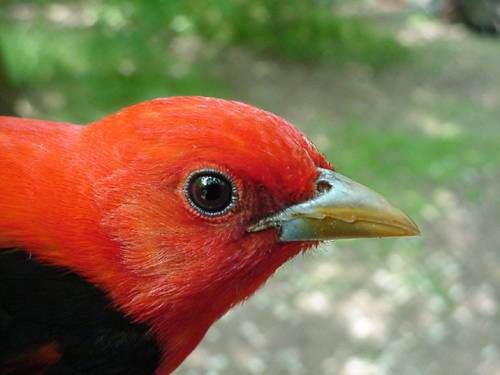


 Oct 15 to Mar 15:
Oct 15 to Mar 15: